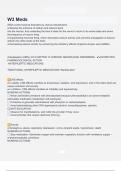STUVIA 2024/2025
W3 Meds
AEDs control seizure disorders by various mechanisms.
● Slowing the entrance of sodium and calcium back
into the neuron, thus extending the time it takes for the nerve to return to its active state and slows
the frequency of neuron firing.
● Suppressing neuronal firing, which decreases seizure activity and prevents propagation of seizure
activity into other areas of the brain
● Decreasing seizure activity by enhancing the inhibitory effects of gamma butyric acid (GABA)
Antiepileptics (AEDs) ATI CHAPTER 13 CHRONIC NEUROLOGIC DISORDERS - ✔✔EXPECTED
PHARMACOLOGICAL ACTION
ANTIEPILEPTIC MEDICATIONS
TRADITIONAL ANTIEPILEPTIC MEDICATIONS "Barbiturates"
⏺CNS effects
%
● In adults, CNS effects manifest as drowsiness, sedation, and depression, and in the older adult can
cause confusion and anxiety.
● In children, CNS effects manifest as irritability and hyperactivity.
NURSING ACTIONS
◯ Never administer primidone with phenobarbital because phenobarbital is an active metabolic
(stimulates medication metabolism cell porphyria).
◯ Primidone is generally administered with phenytoin or carbamazepine.
◯ Avoid administering other CNS depressants (alcohol, benzodiazepines, opioids).
CLIENT EDUCATION
◯ Observe for manifestations, and notify the provider if they occur.
◯ Avoid activities that require alertness (driving).
⏺Toxicity
● Nystagmus, ataxia, respiratory depression, coma, pinpoint pupils, hypotension, death
NURSING ACTIONS
◯ Stop medication. Administer oxygen and maintain respiratory function with ventilatory suppor -
✔✔phenobarbital, primidone
NURSING ACTIONS:
stuvia
, STUVIA 2024/2025
Hydantoins:
⏺CNS effects
● Nystagmus, sedation, ataxia, double vision, cognitive impairment
NURSING ACTIONS: Monitor for manifestations of CNS effects, and notify the provider if they occur.
⏺Gingival hyperplasia
● Softening and overgrowth of gum tissue, tenderness, and bleeding gums
NURSING ACTIONS: Advise clients to maintain good oral hygiene (dental flossing, massaging
gums). Folic acid supplements can decrease the occurrence.
⏺Skin rash
NURSING ACTIONS: Stop medication if rash develops.
⏺Cardiovascular effects: dysrhythmias, hypotension
NURSING ACTIONS
● Administer at slow IV rate (no faster than
50 mg/min) and in dilute solution to prevent adverse cardiovascular effects.
● Avoid administering to a client who has sinus bradycardia, sinoatrial block, or Stokes-Adams
syndrome.
%
⏺Endocrine and other effects
● Coarsening of facial features, hirsutism, and interference with vitamin D metabolism
CLIENT EDUCATION
◯ - ✔✔TRADITIONAL ANTIEPILEPTIC MEDICATIONS NURSING ACTION
● Phenytoin
⏺CNS effects
● Nystagmus, double vision, vertigo, staggering gait, and headache can occur, but cognitive function
is minimally affected.
NURSING ACTIONS
● Administer in low doses initially and then gradually increase dosage.
● Administer the largest portion of the daily dose at bedtime.
⏺Blood dyscrasias
● Leukopenia, anemia, thrombocytopenia
NURSING ACTIONS
● Obtain baseline CBC and platelets. Perform ongoing monitoring of CBC and platelets.
stuvia
, STUVIA 2024/2025
● Observe for manifestations of bruising and bleeding of gums, sore throat, fever, pallor, weakness,
and infection.
● Avoid administering to a client who has bone marrow suppression or bleeding disorders.
⏺Hypo-osmolarity
● Carbamazepine promotes secretion of ADH, which inhibits water excretion by the kidneys and
places clients who have heart failure at risk for fluid overload.
NURSING ACTIONS
● Monitor blood sodium periodically.
● Monitor for edema, decrease in urine output - ✔✔TRADITIONAL ANTIEPILEPTIC MEDICATIONS
NURSING ACTION
● Phenytoin
⏺GI effect
● Nausea, vomiting, indigestion
CLIENT EDUCATION: Take medication with food.
Enteric-coated formulation can decrease manifestations.
⏺Hepatotoxicity
%
● Anorexia, abdominal pain, jaundice
NURSING ACTIONS
◯ Assess baseline liver function and monitor liver function periodically.
◯ This medication should not be used for children younger than 2 years old.
◯ Medication should be prescribed in lowest effective dose.
◯ Avoid administering to a client who has liver disease.
CLIENT EDUCATION: Observe for manifestations of hepatotoxicity (anorexia, nausea, vomiting,
abdominal pain, and jaundice), and notify the provider if they occur.
⏺Pancreatitis
NURSING ACTIONS
● As evidenced by nausea, vomiting, and abdominal pain
● Monitor amylase levels.
● Medication should be discontinued if pancreatitis develops.
CLIENT EDUCATION: Observe for manifestations, and notify the provider immediately if these occur.
⏺Thrombocytop - ✔✔TRADITIONAL ANTIEPILEPTIC MEDICATIONS NURSING ACTION
● Valproic acid
stuvia
, STUVIA 2024/2025
⏺GI effects: Nausea, vomiting
NURSING ACTIONS: Administer with food.
⏺CNS effects: Sleepiness, lightheadedness, fatigue NURSING ACTIONS: Administer low initial
dosage. CLIENT EDUCATION: Avoid hazardous activities (driving).
Antiepileptics (AEDs) ATI CHAPTER 13 CHRONIC NEUROLOGIC DISORDERS -
✔✔TRADITIONAL ANTIEPILEPTIC MEDICATIONS NURSING ACTION
● Ethosuximide
PURPOSE
EXPECTED PHARMACOLOGICAL ACTION
These medications do not halt the progression of Parkinson's disease (PD). However, they do offer
relief from dyskinesias (bradykinesia, resting tremors, and muscle rigidity) and an increase in the
ability to perform ADLs by maintaining the balance between dopamine and acetylcholine in the
extrapyramidal nervous system
%
Dopaminergic medications promote dopamine synthesis, activate dopamine receptors, prevent
dopamine breakdown, promote dopamine release, or block the degradation of levodopa.
Anticholinergic medications block the muscarinic receptors, which assist in maintaining balance
between dopamine and acetylcholine receptors in the brain.
Dopamine agonists, COMT inhibitors, MAO-B inhibitors, dopamine releasers, and centrally acting
anticholinergic antagonists are used concurrently to increase the beneficial effects of
levodopa/carbidopa. - ✔✔Anti-Parkinson's medications
● Dopamine synthesis medications (levodopa) are prepared in combination with a dopamine agonist
(carbidopa), or listed as levodopa/carbidopa.
◯ Levodopa crosses the blood-brain barrier, whereas
dopamine alone cannot cross this barrier and has a very short half-life. Levodopa is taken up by
dopaminergic nerve terminals and converted to dopamine (DA). This newly-synthesized DA is
released into the synaptic space and causes stimulation of DA receptors thus restoring a proper
balance between dopamine and acetylcholine.
stuvia




